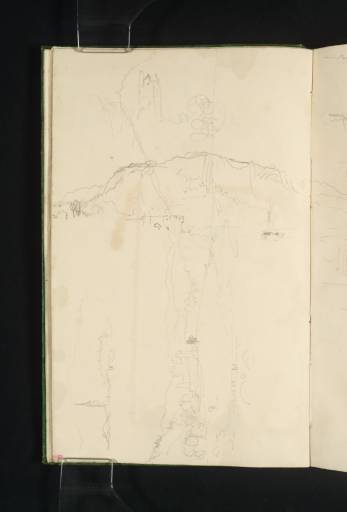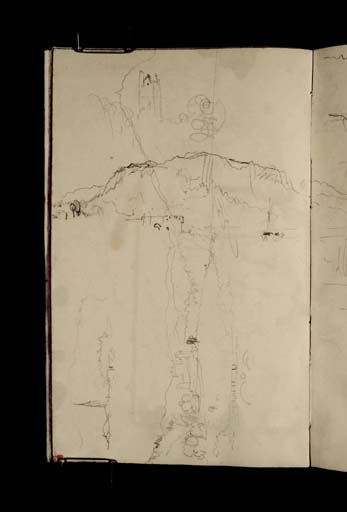Joseph Mallord William Turner Inveraray From Loch Fyne; and Cambuskenneth Abbey, Stirling 1831
Image 1 of 2
Joseph Mallord William Turner,
Inveraray From Loch Fyne; and Cambuskenneth Abbey, Stirling
1831
Joseph Mallord William Turner 1775–1851
Folio 11 Verso:
Inveraray From Loch Fyne; and Cambuskenneth Abbey, Stirling 1831
D26457
Turner Bequest CCLXX 11a
Turner Bequest CCLXX 11a
Pencil on white wove paper, 125 x 201 mm
Accepted by the nation as part of the Turner Bequest 1856
References
1909
A.J. Finberg, A Complete Inventory of the Drawings of the Turner Bequest, London 1909, vol.II, p.868, CCLXX 11a, as ‘Mountains, &c.’.
1936
Henry J. Crawford, Turner’s Sketches and Drawings of Stirling and Neighbourhood With Some Notes on the Artist’s Scottish Tours also A Note on John Ruskin and Stirling, Stirling 1936, p.22.
1990
Dr David Wallace-Hadrill and Janet Carolan, ‘Turner’s Sketches North of Stirling’, Turner Studies: His Art and Epoch 1775 – 1851, Summer 1990, vol.10 no.1, p.17.
This page contains four sketches. Across the width of the page, with the book turned on its side, is the largest sketch which depicts Inveraray Castle as seen from Loch Fyne to the east. Turner crossed the loch from St Catherine’s to Inveraray, and this sketch must have been made as the ferry approached Inveraray Pier. The castle is drawn in outline with two of its corner towers visible. There is a more detailed drawing of the castle on folio 19 (D26472). In front of the castle is Robert Myln’s two-arched Aray Bridge, and to the right is Duniquoich Hill (Dùn na Cuaiche) with a watch tower at its summit. Although only the outline of the hill is given here, Turner drew it in more detail on folio 18 verso (D26471), and had taken a particular interest in it during his previous visit to Inveraray in 1801. A watercolour sketch of the hill and castle from Inveraray pier made during or after that visit shows a similar view to the present drawing (Tate D03632; Turner Bequest LX A).
At the top left of the page is a small sketch of the town of Inveraray. While most of the town is reduced to a jagged line representing the rooftops, the spire of Inveraray Parish Church is depicted more clearly. This was perhaps of particular interest to Turner as it had not yet been completed when he visited the town in 1801, and a watercolour made in about 1803 shows it being constructed: Inveraray, Loch Fyne circa 1803 (Manchester City Art Galleries);1 the spire was demolished in 1941. For references to all of Turner’s sketches of Inveraray in this sketchbook see folio 19 verso (D26473).
Cambuskenneth Abbey is shown again in the sketch below which continues on folio 12 (D26458). The view shows the hill of Abbey Craig from across the River Forth to the south-west, with a boat in the water and the abbey at the right of the hill on folio 12. Turner also made a number of sketches of Stirling from around this area on folios 12 verso–14 verso (D26459–D26463), including the sketch that formed the basis of his watercolour, Stirling circa 1834–5 (Glasgow Museums).3
Thomas Ardill
June 2010
How to cite
Thomas Ardill, ‘Inveraray From Loch Fyne; and Cambuskenneth Abbey, Stirling 1831 by Joseph Mallord William Turner’, catalogue entry, June 2010, in David Blayney Brown (ed.), J.M.W. Turner: Sketchbooks, Drawings and Watercolours, Tate Research Publication, December 2012, https://www


